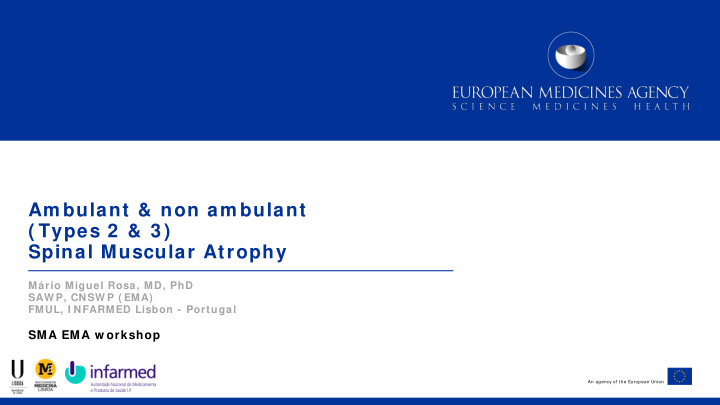



Am bulant & non am bulant ( Types 2 & 3 ) Spinal Muscular Atrophy Mário Miguel Rosa, MD, PhD SAW P, CNSW P ( EMA) FMUL, I NFARMED Lisbon - Portugal SMA EMA w orkshop An agency of the European Union
Content Relevant SMA characteristics Population Assessment of treatment effect Study design Other issues What can EMA offer? 1
Spinal Muscular Atrophy – Relevant aspects Predominantly Neuromuscular Disorder • Continuum of clinical presentation • Motor milestones achieved up to a certain level, then decreasing progressively Under treatment – Cinical stabilisation / improvement / worsening as variables • Different genetic forms / SMN copies – Patient population refinement • Progression speed – study duration timeframe 2
Pathophysiology Direct • Motor spinal neurons impairment • Other tissues involvement (Skin?) Indirect • Dysphagia - wasting • Skeletal dysmorphia • Respiratory failure • Infections The contribution of mouse models to understanding the pathogenesis of spinal muscular atrophy Sleigh J et al. Disease Models & Mechanisms 2011 4: 457-467. 3
Population Trial population / Extrapolation • SMA 1 vs SMA 2 vs SMA3; • SMA 1 vs other SMA • SMA early onset vs late onset SMA (cut off at 6Mths?) Ambulant vs non ambulant (at time of screening) Literate vs preschool patient SMN2: 2 copies vs 3 copies vs 4 copies Severe clinical status vs moderate clinical status (at time of screening) Pre-symptomatics 4
Pre-symptomatic patients Importance in late onset SMA Genetic testing in pre-symptomatic children • ethical / legal issues if no approved therapy available SMN2 copies CMAP / MUNE neurophysiology … 5
Assessment of treatment effect in SMA types 2 & 3 Matching • Disease severity (non ambulant / ambulant) • Learning abilities (infants / children / adolescents) – test performance – More complex than SMA type 1 • Tool features – Discriminative power – Floor effect – Ceiling effect 6
Assessment of treatment effect in SMA types 2 & 3 Tools needed for: • Global Function • Motor function (pyramidal tract) – MFM 32 vs 20; MFM total vs D1+ D2 domain – CGI – HFMSE (sitting, non ambulant patients) – PGI? • Common morbidities – 6MWT (fatigue) • Respiratory function – Age limits to control for scoliosis / respiratory • ADL / Learning abilities – Time to ventilation • Non invasive? (16 hours per day?) Invasive? • QoL – FVC – PedsQL • Caregiver burden • Pharmacoeconomic endpoints 7
Potential surrogate endpoints Motor neuron related • SMN transcript and/ or protein Hard Clinical • CMAP, MUNE, EIM • … Relative External correlation validity to Extra Unable to measure influence disability polation Surrogate of comorbidities Not a global assessment tool 8
Study design Comparator • Historical comparator • Placebo – Valproate – Best medical treatment • evolution Rak K et al, Neurobiol Dis. 2009 Dec; 36(3): 477-87. – Earlier diagnosis – treatment support Treating agent may also be deleterious – Best medical treatment inhomogeneity among study centres 9
Study design Comparator • New approval scenario – Use of placebo vs newly approved agent • Different indication • Demonstration of superiority – Significant benefit 10
Study design Adaptive design Vs Exploratory ↗ Confirmatory design Regulatory requirements at MA: • Post approval registries • Post Approval efficacy studies • Post Approval Safety Studies 11
Other issues Study duration Study enrolment and stopping rules Cut-off points: • a) when to start treatment – some already highly disabled infants do not improve and treatment might just prolong time to ictus, with no benefit • b) when to stop treatment – lack of treatment effect – definition of responder 12
HTA assessment facilitation Market Authorisation is different from treatment access How to prepare for HTA • Natural history cohorts • Pharmacoeconomic friendly endpoints • Duration of treatment estimate 13
What can EMA offer? Early access for scientific advice and protocol assistance • All development phases (SA and PA); PRI ME: • Selection / recommendation on specific assessment tools priority m edicines (Qualification Advice and Qualification Opinion) Fostering early dialogue • PRIME among stakeholders Early access to the market • Patients (Conditional Marketing Authorisation) • Drug developers • Investigators / Speeded procedures Clinicians (Accelerated Assessment for MA) • HTA 14
Thank you!
Recommend
More recommend